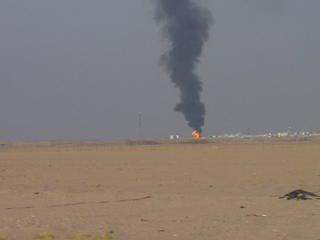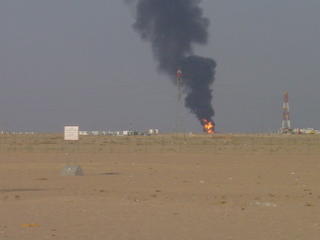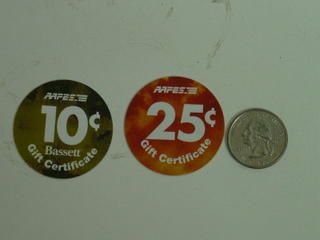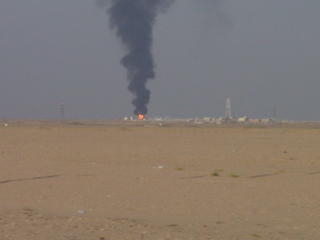27 October 2005
Today's 11B Warrior
As I sat there with my own bowl of ice cream, I thought about how the soldiers before me spent their time between missions. In some ways, I concluded, we got it made. We’ve got all these amenities—communications, computers, decent food, music, movies, new technologies, etc. But, I thought, while these amenities are nice, they don’t take away from the essence of war in being an American soldier: risking one’s life and health, suspending one’s own individual freedoms for a while, and being separated from one’s family and loved ones, all for the benefit of others, in furtherance of national interests, and/or in fulfilling the calling of one’s principles and values.
As I finished up my ice cream, my mind shifted to the upcoming task at hand: that night’s mission. We had to move 30 trucks from Anaconda to Forward Operating Base (FOB) Warrior, a base on the outskirts of Kirkuk. For this mission, we had three gun trucks to protect all 30 trucks that we were escorting.
This mission, like most, had an early morning SP time (start time) of 0100. We gathered around midnight to conduct our PCC/PCIs—we checked our NVG’s, weapons, fuel cans, flares, grenades, vehicles, ammunition, combat lifesaver bags, etc. All was ready. We were ready.
As a sign of the "next generation" warriors that we have become, we stopped at a coffee shop on post at Anaconda to get our fix of caffeine just prior to the mission--not the traditional nasty army brew, but lattes, cappuccinos, mint teas, frappes, etc. instead. The notion still makes me smile. Yes, this is today's 11B, the grunts of yesteryear have turned into specialty coffee connoisseurs of today. I (at least) stayed with a traditional large black coffee, but I guess I'm one of the old-timer stalwarts.
We moved to the SP point and crossed the SP at the correct time. About three quarters of the convoy made it through the gate when I heard someone on the radio saying, “we’ve got an issue back here.” A white truck (one driven by a third country national) had a mechanical issue and blocked the serpentine maze at the gate entrance. We couldn’t move the rest of the convoy out or return the convoy in the gate without fixing or moving the white truck. To exacerbate the matter, the area outside of this particular gate was rather dangerous--it had seen several consecutive nights of small arms fire. So, we were stuck there until the truck that broke down could be moved or fixed. Luckily, they were able to fix the truck within an hour or so. We found out later though that AIF forces had struck that stretch of highway about an hour or so after we left.
The routes we travel often vary depending on the most recent intelligence reports we receive. While it was the least dangerous route that evening, the route that was selected for us that night took us through some fairly rough areas, including parts of downtown Tikrit (Sadaam’s hometown).
At about 0330 that morning, we approached Tikrit. On the outskirts of Tikrit, we saw a well-lit bridge that had a significant amount of debris on the right side (northbound) lanes—some type of explosion had apparently occurred there earlier that morning. On the far side of the bridge, we saw an IP (Iraqi police) car.
IPs are tough to deal with. While I know that probably a majority of them are good and at least neutral to the US presence, a very significant percentage of IPs are not trustworthy (at best) and are either corrupt or supportive of the AIF (at worst). As a result, IPs are (generally) viewed very suspiciously by coalition forces (especially the Brits).
So, there we sat: a convoy that stretched 1½ - 2 miles long on the verge of entering Sadaam’s hometown crossing a bridge that had seen an explosion a few hours earlier. On the far side of the bridge was an IP car on the southbound side with its lights flashing. We couldn’t just sit there. The exposure of the convoy to RPGs, VBIEDs, and small arms fire was much too large to stay there for any significant duration.
We decided to cross the bridge on the south bound (left) side—my vehicle first. We moved up cautiously looking for any evidence of IEDs or potential ambush. I could practically hear the fast pace of each of the hearts of the solders in my vehicle. That level of tension is what is commonly referred to a “high pucker factor.” We used the NVGs and binos to see if we could see any enemy activity as we traversed the bridge. As we crossed the far side of the bridge, we looked into the IP car. It was empty. Nothing was around. The streets were ominously quiet; all that could be heard was the diesel engine of our gun truck HMMWV and the distant sound across the bridge of the engines of the trucks waiting to cross the bridge. We cleared the far side of the bridge and signaled for the convoy to cross.
We proceeded to lead the convoy through a part of Tikrit. The built up areas in the city were among the nicest we’d seen in Iraq. Though, there clearly were areas where gun fighting and explosive devices had been used in the recent past. There were also several rubbled and abandoned buildings. We ran across a number of IP cars with IPs just emotionlessly looking at us as we passed.
As we were driving through the built up areas (which is a very risky thing to do, especially with large vehicles), we noticed that there was a significant ambiguity in the strip map we were given. The turn off from the main road was not clearly designated on the map (no grid coordinates, no street names, and no detail in the map). We had to guess which street was the proper street onto which to turn. Unfortunately, we guessed wrong.
We were off by one street. The problem was that there was no way to correct the mistake without turning around the entire convoy. Turning around a 30-vehicle convoy containing semis is not a small feat. Making it worse, the road that we were on was getting narrower and the area was becoming more built up (3-5 story buildings). If AIF were out that night in Tikrit (and prepared), we would have been in store for a lot of trouble. I’m pleased to report that they weren’t.
We found a place to turn around and were able to do so without incident. We headed out of Tikrit as fast as we could (safely). But that wasn’t the end of the excitement for that early morning.
Outside of Tikrit there are several large hills. Inside the hills are a number of caves, where it is known that AIF leaders meet. We seen activity (movement of individuals) in the hills, which only elevated the tension (or pucker factor) level.
One of the things that we do when securing a convoy is to ensure that no vehicle passes or enters the travel area of the convoy. Think of it as a bubble or buffer zone. As part of securing what’s in the convoy, we prevent anything from entering the bubble or buffer zone around the convoy. Iraqi drivers know this. They typically pull over if the convoy approaches them and they standoff at least 50-100 meters from an intersection where a convoy is turning. The lights from convoys traveling at night are very distinct (bright and long strings of lights). They can be seen typically for miles, making convoys relatively easy targets for which to prepare an IED or ambush in a short period of time.
As we passed through the hills, we had a number of vehicles that violated our buffer zone. We fired a number of warning shots near vehicles that did this. Hearing and feeling that 240B (pronounced, two-forty bravo) or M2 (pronounced, em two or ma deuce) firing from the top of your gun truck at or near vehicles is an interesting experience.
As we made it out of the hills, the traffic became more sporadic. We ran across a few areas that had been IED strike locations earlier that morning or during the evening prior, but we did not run into any IEDs.
By 0700 or so, we made it to Kirkuk, just in time for the area rush hour. I don’t think I would wish on many people the task of taking a 1½ - 2 mile long convoy through the rush hour of one of the largest Sunni cities in Iraq.
Thankfully, we made it through the portion of the city we had to travel across without any significant episodes.
Upon arrival at FOB Warrior, we collectively let out a big sigh. A successful mission—no deaths, no injuries, and no damage to the equipment that was delivered on time. We then laughed and mused about the mission we just ran. I felt the great feeling of having an incredible weight lifted off of me coupled with the pride of how well my fellow soldiers performed early that morning.
We couldn’t enjoy the moment too long or let our guard down. Within eighteen hours of our arrival, FOB Warrior received two mortar attacks, several small arms fire engagements, and a VBIED. And then, of course, we had to leave at 0600 the next morning with the same convoy of vehicles carrying a backload of equipment south through another high activity area in Iraq. But that was another mission.
15 October 2005
Kuwaiti Oil Fires
Most people remember (at least those who were adults at the time) that when Sadaam Hussein retreated from Kuwait during the first Gulf War, he dumped millions of gallons of oil into the Persian Gulf and started ablaze hundreds of oil wells (cumulatively burning more than a billion gallons of oil). There were photos taken from outer space that showed the blackened skies surrounding the Persian Gulf. Much was written about the likely increased cancer rates of area residents and the impact that the fires had on some soldiers in the area (many saying it was a contributor/cause of Gulf War Syndrome).
About a year or so ago, I had heard that there were several of these fires still going. The reason, if I recall correctly, is that they assume that there are various forms of munitions that had been inserted in these lakes of oil prior to them being set fire. Trying to cap these fires may actually cause more explosions—thus, they are just cordoning the areas off and letting them burn.
On the way to southern Kuwait, we drive through these areas where we can see several fires extending more than 100 feet high. Here are a couple more pictures:


10 October 2005
Oddities
1. Pogs. AAFES, kind of like a nonprofit, monopoly, army-version of a shopko-walmart (or in some cases, stop-n-go), has decried that it no longer wants to deal with pennies and most other coins. So, it has developed and issued a second form of currency that everyone calls "pogs." It’s gotta be illegal. AAFES describes them as “gift certificates” and not a second form of currency though.
They're made out of thick card stock paper. Here’s a picture:

The problem with the “gift certificate” notion is that no one goes into an AAFES and hands the checkout person $2.00 to purchase toothpaste for $1.50 and then says, “by the way, let me have an AAFES gift certificate for $.50.” It's a red herring. I’m sure the gift certificate designation is only part of a scheme to avoid the second form of currency issue. Still, this whole pog thing is strange.
2. Rounding Up. Well, since I’m on an AAFES kicking spree, I’ll continue. AAFES over here always “round up” to the nearest nickel when they charge at the cash register. So, if the price tag says that it costs $1.96, AAFES will charge you $2.00. Anyone want to start a class action lawsuit?
3. Toilet paper. Read on, it’s not what you think. The Army does a wonderful thing here in that they have wash stations in front of the mess hall so that all soldiers wash their hands before eating (which they do—compare that to civilians where most civilians before most meals, don’t). They also have wash stations outside of all port-a-johns as well, which is all great. But, in most places where they have these wash stations, the only thing you have to dry your hands with is toilet paper dispensed from these large toilet paper rolls. This practice is prevalent in both Iraq and Kuwait.
4. Travel and Commerce. Soldiers are generally prohibited from visiting any restaurants, shops, or other merchant stores in Kuwait. Unless out on a mission or making a military supply or maintenance-related run, soldiers are generally restricted to the camp, base, FOB, etc., that they are stationed at. I guess I expected that in Iraq, but not Kuwait.
5. Haircuts. A military haircut is a military haircut, right? Apparently not. The barbers here are from India. The cuts are very cheap--$5.25. After you get the cut (which is middle of the road in terms of quality), the barber treats your head like a speed bag (a la boxing). He puts either a fist or open hand (depending on which barber you get) on each side of your head. He then proceeds to wack each side of your head, back and forth, for about 15 seconds. The barber then moves to the shoulder and neck area, making various mysterious popping sounds as he hits your body with his hands that are now clasped in a certain way. He uses a rotating motion across the shoulders and neck area, making repetitive contact with various points. Then, before you know it, he is done. Afterward, you don’t know if you should thank him or file charges.
6. Advertisements. I don’t have a TV but they do have TVs in the mess hall. There are no product advertisements on TV. Instead, the military, in the controlling way that it operates, broadcasts public service and “be a good soldier” messages. For example, there will be information on operational security (loose lips, sink ships type messages), the importance of education and safety (e.g., driving, clearing weapons, using the buddy system), and how to marry a foreigner (Europe and Eastern Asia-focused). So, there will be one of these spots for every commercial that one would normally see back in the States—i.e., there are a lot of them. I should have recalled this when I was on active duty overseas earlier, but I forgot.
I could go on . . . perhaps on another day.
04 October 2005
Ramadan
For more than a billion Muslims around the world, Ramadan is observed as a “month of blessing.” Ramadan is the month when Allah revealed the first verses of the Koran, the holy book of Islam, to Muslim's highest prophet, Muhammad. Recitations, fasting and charity are required (by law in many places over here) during Ramadan as spiritual activities that can bring Muslims closer to Allah. While fasting, Muslims do not allow anything, including cigarettes and liquids, to pass their lips. The fast lasts from dawn to dusk every day during the month of Ramadan. Ramadan is also one of the four “haram” months when fighting is discouraged.
Despite all this, Ramadan (at least) recently has marked a significant up tick in violence. On the day Ramadan began last year, four Christian churches were bombed (about 2-3% of the Iraqi population is Christian). The year prior, the beginning of Ramadan saw four near-simultaneous suicide bombers strike the international Red Cross headquarters in Baghdad and three police stations across the city, leaving at least 40 people dead and 200 wounded.
Ramadan begins on the ninth month of the Islamic calendar. This year, Ramadan should begin on October 4 (tonight). The actual first day of Ramadan may vary depending on whether someone (reliable) sees the first sliver of a moon (if no one sees it, the beginning of Ramadan is postponed a day). You can tell there's a different atmosphere here among the workers who are Islamic. The local mosque's calls to prayer seem to be longer or more prevelant.
As with last year, many expect Ramadan to bring more violence and bloodshed than other parts of the year. I have not heard a satisfactory reason for this nor do a really understand why it would be so. I’m just hoping it doesn’t. But, we're ready for it, if it does.
